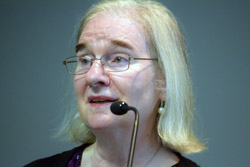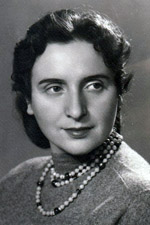By Donald H. Harrison


SAN DIEGO—Perhaps if the late Yiddish novelist Chava Rosenfarb had lived to see how many people crowded the Seuss Room at UCSD’s Geisel Library to hear a discussion about The Tree of Life, her trilogy about life in the Lodz ghetto, the depression she felt over the fate of the Yiddish language might have been lifted.
“What affects me the most,” Rosenfarb once wrote, “is the continual sense of isolation that I feel as a survivor, an isolation enhanced by my being a Yiddish writer. I feel myself to be an anachronism wandering across a page of history on which I do not belong. If writing is a lonely profession, then the Yiddish writer’s loneliness has an added dimension. Her readership has perished. Her language has gone up with the smoke of the crematoria. She creates in a vacuum, almost without an audience, out of fidelity to a lost community whose language this was; as if to prove that Nazism did not succeed in extinguishing its last breath, that it is still alive. Creativity is a life-affirming activity. Lack of response and being condemned to write for the desk-drawer, is a stifling, destructive experience. Sandwiched between these two states of mind, struggles the spirit of the Yiddish writer.”
The audience that attended the 5 p.m. lecture by Rosenfarb’s daughter, Prof. Goldie Morgentaler, on Wednesday, May 11, numbered somewhere around 100, and that was after at least half that number had also attended a 3 p.m. showing of a Yiddish language documentary in which Rosenfarb discussed her works with an interviewer.

True, Morgentaler’s lecture about her mother’s writing was given in English, but there clearly was interest in Yiddish literature among community members and students who contributed to the 5 p.m. standing-room crowd. “It was without a doubt one of our best events of the year, and the audience was clearly fascinated,” commented Susanne Hillman, coordinator for UCSD’s Holocaust Living History Workshop. “It was wonderful!” said Brian E.C. Schottlaender, The Audrey Geisel University Librarian, about the combination movie-and-lecture program that was underwritten by Jewish community member Laurayne Ratner.
It was no accident that Morgentaler, a professor of English literature at the University of Lethbridge in Canada’s Alberta province, could channel Rosenfarb so well. She is not only the daughter of the Yiddish writer, who died in 2011 at the age of 87, but also is her literary translator. It’s not any stretch of the imagination to say that she is almost as familiar with The Tree of Life—all three books of it—as was her mother. And while Morgentaler is, of course, a loving daughter, she also is a trained literary analyst, who teaches the works of Charles Dickens, among other English language writers, to her university classes.
Rosenfarb began writing poetry as a child, her verses so precocious that her proud father, who was a waiter in one of the finer restaurants in Lodz, Poland, could not resist passing copies of her work around to friends and patrons. When only 17, Rosenfarb and the other Jews of Lodz – which once boasted Poland’s second highest concentration of Jews, behind only Warsaw – were shut into a barbed wire ghetto, where amid increasing privations, they tried to adjust to their new lives and to retain what was good from their old ones. Rosenfarb’s poetry soon attracted the interest of a circle of Yiddish writers led by Simkha-Bunim Shayevitch, who came to consider her his protégé.
 The Tree of Life, written years after the Holocaust, follows the lives of ten characters in the Lodz Ghetto, one of them being Rosenfarb’s alter-ego, whom she named Rachel Eibushitz, a “high school student.” Another was Rachel’s boyfriend, David, a diarist, who is modeled on Heniek Morgentaler, the man who became Rosenfarb’s husband (and who much later in life became the doctor who was Canada’s most well-known advocate for abortion rights.)
The Tree of Life, written years after the Holocaust, follows the lives of ten characters in the Lodz Ghetto, one of them being Rosenfarb’s alter-ego, whom she named Rachel Eibushitz, a “high school student.” Another was Rachel’s boyfriend, David, a diarist, who is modeled on Heniek Morgentaler, the man who became Rosenfarb’s husband (and who much later in life became the doctor who was Canada’s most well-known advocate for abortion rights.)
Readers meet Rosenfarb’s characters at a New Year’s Party at the beginning of 1939, nine months prior to the time Poland was invaded by Germany. In the first book, their “normal” lives are sketched. The second book tells of deteriorating life in the ghetto, and the third book tells of the last two years in the ghetto before it was “liquidated” by the Nazis. After being sent to Auschwitz by the Nazis, and forced to stand naked before them, Rosenfarb decided that if she survived she would write a novel about the characters who peopled Lodz.
Rosenfarb paints her characters objectively, not sentimentally. British Rabbi Lionel Blue famously said “Jews are like everyone else, only more so,” and a panoply of human personalities are represented in Rosenfarb’s depictions of Lodz’s Jewish ghetto. While some of her characters are fictional, others are well-known persons such as Mordechai Chaim Rumkowski, who headed Lodz’s Judenrat, the organization created by the Nazis to carry out its orders in the ghetto.
According to Morgentaler, “Rumkowski is a man whose personality and motives have been much debated by historians. If Rumkowski does not emerge from Rosenfarb’s pages as likable, he does at least appear knowable. When we first meet him… Rumkowski is soliciting funds for the orphanage… Scenes set in the orphanage make it clear that Rumkowski loves the adulation of those who are weaker than he. The old man has a weakness for young girls and… he attempts to seduce a young girl from the orphanage, Sabinka, whom he has treated to an afternoon at the fair grounds of Luna Park. Rumkowski’s near-rape of the innocent fifteen year-old Sabinka in the outlying bushes of the park is interrupted by some Polish boys, chanting ‘Hep, hep, give it to her old Jew boy! Give it to her!’ The reminder here is that the Jewish world of pre-war Poland is hedged around with anti-Semitic hatred, even before the Germans march into the country. And the irony here is that this same anti-Semitism of the Polish thugs saves the innocent Jewish girl from assault by a Jewish predator.”
As a personage in the book, Rumkowski appears a complex, sometimes contradictory, human being. At times he is altruistic, even brave, as when he rescued some Jews from the hands of the Nazis only to be beaten for his troubles. In as much as Rosenfarb did not know Rumkowski personally, “the portrait in The Tree of Life is fiction,” comments Morgentaler. “But clearly it is the moral ambiguity of Rumkowski’s position that fascinates her, the kernel of good overlaid with layers of self-delusion, megalomania, and petty cruelty.”
Rosenfarb described details of everyday life in the ghetto, from food distribution, to work shops. The Tree of Life “describes the gatherings of the ghetto intelligentsia and the Jewish underworld, as well as the ideological responses of the various political parties—the Zionists, Communist and the Bundists,” Morgentaler said. “Most importantly it gives a portrait of that section of ghetto society that Rosenfarb knew well from personal experience, the Lodz Ghetto’s artistic community. Her portrayal of the tenacity and bravery of this community includes fictionalized portraits of the real-life poet Miriam Ulinover, at whose apartment the writers group meets, and the painter Israel Leizerowicz,” whose photo is featured on the cover of the English language edition of The Tree of Life. Leizerowicz was murdered at Auschwitz, but many of his paintings survived to be housed today at the Jewish Historical Institute in Warsaw.
At a post-speech dinner in La Jolla Village where she was joined by Hillman, Schottlaender, and her husband, Math Professor Jonathan Seldin of the University of Lethbridge, Morgentaler was asked why her mother decided to write a novel rather than a memoir. In e-mail correspondence, she later responded. “I think she felt greater freedom in writing about people like Rumkowski and the other characters when she was not tied to historical facts. She could imagine them better that way. Also, if the purpose of the novel was to re-create an entire ghetto community as she knew it, she could not limit her prspective to only one character, as she would need to do in a memoir…
“My mother did a lot of research while she was writing the novel. For instance, Rumkowski’s speech asking the mothers to give up their children is reproduced word-for-word in The Tree of Life because, my mother said, nobody could make up anything so horrible.”
Does the interest in Yiddish literature give hope of its revival? “I am not sure my mother ever believed that Yiddish could be resuscitated as a daily language of the Jews,” Morgentaler responded. “She was too much of a realist for that. Personally, I don’t think it can be eitehr. But I love the language and I do hope that enough people keep speaking it so that it does not die out entirely–and that is certainly possible. It is the language of about 1,000 years of Ashkenazic Jewish life in Europe and losing it means losing a large part of our history.”
*
Harrison is editor of San Diego Jewish World. He may be contacted via donald.harrison@sdjewishworld.com Comments intended for publication in the space below MUST be accompanied by the letter writer’s first and last name and by his/ her city and state of residence. (City and country for those outside the United States)